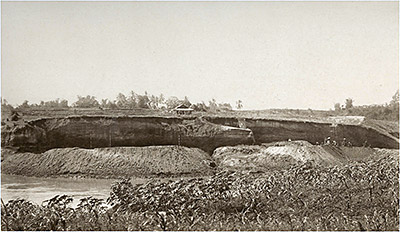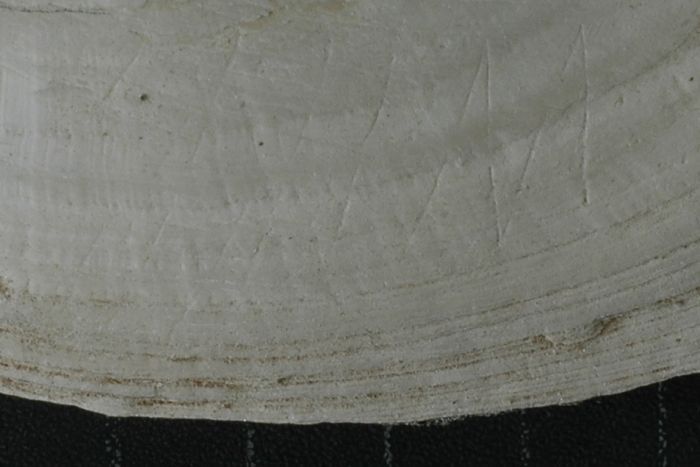Springtime on the Georgia coast, and already the woods are melodious with the calls of the Painted Bunting scouts. How lovely - it is time to put out the white millet to greet them at the feeders.
Read MorePrehistory
Mind-stretching Art /
I knew it was important to see. But the weather forecast was for snow, sleet, rain and high winds. And it was a long drive. Nonetheless, I went.
Where? Well, to one of the really important caves for prehistoric art in the Pyrenees in South France. To Niaux Cave, to be exact, in Niaux, south of Foix, the centre of the Ariège district.
In a way, the stage is well set for the interior of the two-kilometer long series of interlocking caves by the dramatic Corten steel building-cum-sculpture which marks today's entrance to the cave. Massimiliano Fuksas' architecture is somehow as wild and fanciful as any imaginary creature that could emerge from the caves.
After a long, wet tramp into the dramatic galleries of the cave, lit only by each person's individual torch issued to us, I began to have the sensation of inexorably walking backwards in time. First this was helped by all the graffiti on the walls, signatures of earlier visitors dating back as far as 1602.
Then came wall marking far earlier than that - red and black dots and lines, early man's geometrical marks.
We penetrated further and further into the ample, swooping roofed galleries that had been sculpted by water over millennia. It was quiet and mysterious. Only the sound of footsteps, the occasional splosh as someone stepped into one of the numerous large puddles, and the dancing beams of light catching the sparkle of minerals on the tumultuous ceilings.
Then suddenly our soft-spoken, knowledgeable young French guide stopped by a large flat rock. She asked us to turn off our flashlights and put them on the rock. Total silent darkness, as each of us wondered what happened next.
We were told to follow a stainless steel railing with our hands as the guide's light led us along. Another pause. Then she switched on a powerful white light, training it on the cave wall. Perhaps the children in the group expressed our emotions best - they simply gasped and shrieked, "Chouette!" - "Cool!".
Before us was the first complex grouping of black drawings - interlocking bison, horses,deer, even an exquisitely stippled ibex. Outlines, some use of the rock wall contours, a sureness of line and touch that was fresh, sophisticated and powerful, totally arresting. Animals depicted in silhouette, the bison with lances sometimes in their flanks, all represented with amazing accuracy and knowledge.
As we moved slowly round the Salon Noir, with the light shone brilliantly and briefly on each panel, followed by darkness once more, the "ceremony" of viewing became more and more an incantation, an altering of one's sense of the here and now. Evocations were made of the different interpretations of these works of art, buried so far in the depths of the earth, - religious, symbolic, shamanistic... We shall never know for certain, but the ensemble of animals, symbols and signs seems to represent views of worlds beyond the Magdalenians' daily lives, worlds where society's problems were thus resolved and in which harmony was restored.
Trying to enter the mind of those far-off Magdalenians is not easy. With such fluidity and knowledge of form, they were drawing these astonishing images on the rough walls of Niaux 14,000 years ago for the most part, or incising images on the floors of the caves. Nonetheless, I found another fact to be even more mind-bending. One series of bison drawings, on the other side of the Salon Noir to the main groups, is apparently dated to about 13,000 years ago. In other words, a thousand years later, other artists drew very similar groups of images, in the light of flickering flares.
Something even more astounding was then softly explained by our guide. Apparently there is a very similar series of drawings in the Grotte Chauvet, miles away in the Ardèche region of France, that resembles those in Niaux. The one important fact that required endless verification and ultimate confirmation: the Grotte Chauvet drawings were done at least 14,000 years previously.
To think that our ancestors could echo the same images and approach to creating drawings of bison and other animals 14,000 years later, without any of our present means of recording images by paper, camera, scanner, whatever – it is almost beyond comprehension.
For me, this was the summum of mind-stretching dislocation about the power and importance of art, whatever its ultimate meaning for those who created it and viewed it in those quiet natural cathedrals beneath the earth.
I was more than glad I had made that snowy trip through the Pyrenees!
We have been Around a Long Time as Artists! /
What a perfect beginning to the New Year! If I ever doubted that, as an artist, I am following a very ancient and venerable tradition, I had fascinating confirmation that I - and every other artist in the world - follow in extraordinarily ancient footsteps.
I read today that a mussel shell, found over a hundred years ago in Java, Indonesia, but recently re-examined, was apparently decorated by our hominid ancestors, Homo erectus, at least 430,000 years ago. No wonder the press was agog in early December, onwards.
Yes, 430,000 years ago! Someone engraved zigzags like an "M", a couple of parallel lines and a reversed "N" shape on the mussel shell. Another shell found had a deliberately sharpened edge that was polished to serve as a cutting tool. So abstract art and even symbols apparently existed many, many thousands of years before Homo sapiens made his/her appearance and made engravings in South Africa.
I think this is the perfect inspiration to salute the New Year. We go back a very long way as artists, and that liberates each of us to do what sings in our hearts and impels us to create.
Happy New Year, everyone!
"Cannibalising" the World /
Joan Miro famously once remarked that "That magical spark is the only thing that matters in art". In other words, he noticed and absorbed everything imaginable around him in his life, cannibalised it and transformed it into art, especially in his sculptures. The most amazing things became part of his art, from his children's toys to the famous paper bag which caused one of his foundries to exclaim, "You expect us to cast a paper bag?" The answer was yes, in bronze!
Miro - sculpture, image courtesy of Jeff Epler
To me, the lesson Miro gives us all is that as artists, we have to be open to every possible resource, every possible influence, because from it, and usually from the most unlikely of instances, comes the spark that leads to creation of something new in our art.
We all know about those moments when we pass something which is part of our daily life and which, until magic suddenly happens, has been unremarkable. Then, unexpectedly, the light falls on the object in a certain way, or there is a new relevance to it because of something else going on in our head, whatever. Then the "cannibalising" happens, and we can incorporate a new dimension into what we are creating.
Other times, the world becomes fresh and exciting because of a visit to somewhere new, which talks to one. That little voice inside one's head says, "Pay attention, this is important", even though, at the time, you don't really know why.
This happened to me in Matera, South Italy, when I was looking at Neolithic shards of pottery in the Archaeological Museum. They fascinated me, and I draw a lot of them, something I normally don't think of doing. But as I drew them, I began to realise I was linking back to early artists who had, in their turn, looked around them in their world and cannibalised images from what they saw. This was a link of many thousands of years, a fact which made an even greater impression on me.
Once home again, I realised that these notations that I had made were potentially the basis of a series of silverpoint drawings. I was cannibalising on the world I had encountered in Matera, in essence. This is one of the drawings.
Basilicata # 3 - silverpoint, Jeannine Cook artist
Thanks to those artists working aeons ago, I started doing work that is totally different from my normal drawings. Sometimes it is definitely fun to be a "cannibal of the world".















